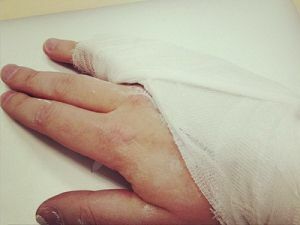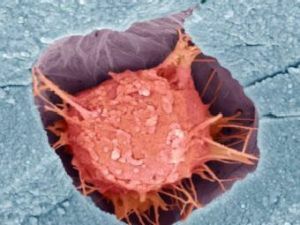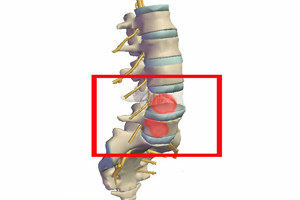 The axis of the body is the spine, consisting of separate vertebrae, which in normal form are strong, withstand heavy loads.
The axis of the body is the spine, consisting of separate vertebrae, which in normal form are strong, withstand heavy loads.
But bone strength is limited in impact, and in some diseases it becomes fragile.
As a result, in some circumstances, there is a compression fracture.
With a strong fracture, the damaged posterior region of the vertebra can penetrate into the spinal canal, acting on the spinal cord and breaking it. Such a process appears slowly and after such traumas neurological symptoms do not immediately become noticeable.
The lumbar region can be damaged most often, since it involves high loads and degenerative-dystrophic diseases. Basically, the first vertebrae suffer as a result of squeezing the nerve roots.
Contents of the article
- How can I get injured?
- Trauma severity
- Symptoms depending on the location of the injury
- Diagnosis
- Complex of medical measures
- Rehabilitation period
- What is the danger of injury
- How to avoid unnecessary problems
How to get injured?
Fracture of the spine refers to serious pathologies, can be complicated and uncomplicated. The uncomplicated has mild signs in the form of non-intensive pain, so patients do not go to the hospital. But a fracture brings discomfort in everyday life, can cause serious complications in the future.
Such a fracture differs from other damage by the pattern of disturbances, as well as by the process that occurs when an injury is sustained.
Disturbance occurs when one vertebrae is squeezed by another or at the same time several parts when the integrity of the structure and bone tissue is disturbed.
There are several forms of compression fracture of the spine. If the damaged parts of the spine remain in place, then this is called a stable fracture. When the vertebrae move to different zones, the disturbance is called unstable.
There are several reasons that cause a compression fracture in the lumbar spine: 
- fall from a large height;
- injury in the event of an accident;
- gunshot wound;
- sports damage;
- osteoporosis, tumor growths in the spine and other disorders that reduce the strength of bone tissue.
Fractures can lead to falls on the pelvic region, back or legs, jumps with landing on the buttocks or legs, incorrect loads during sports activities or minor sharp bumps.
Fracture of the spinal column may appear when the cartilage "sags" in the mesenteric disc, which loses its damping functions when certain diseases occur. At the same time, bone structures become unprotected, and a small impact becomes sufficient for damage.
The occurrence of such disorders is affected by improper diet, metabolic and endocrine function disorders, overweight, inappropriate absorption of calcium. A significant impact in the destruction of bones is played by syphilis, cancers and tuberculosis.
Degree of severity of injury
 Compression fracture is subdivided in degrees of severity. Doctors isolated the first degree( with a slight shift, a decrease in the height of the vertebra to 50% of the volume), a second degree( with a 50% shift from the normal state) and a third degree( with significant displacement and decrease in the vertebra).
Compression fracture is subdivided in degrees of severity. Doctors isolated the first degree( with a slight shift, a decrease in the height of the vertebra to 50% of the volume), a second degree( with a 50% shift from the normal state) and a third degree( with significant displacement and decrease in the vertebra).
Sometimes, damage can develop in a hidden and uncomplicated form, when a person has mild pain. The danger of such a fracture lies in its consequences associated with radiculitis and osteochondrosis.
Symptoms depending on the location of the injury
The compression fracture of the spine of the lumbar region is manifested by the following general symptoms:
- pains that appear in any position and are different( acute or moderate in nature);
- weakness and numbness of the limbs;
- partial lameness;
- discomfort when emptying the intestine and bladder;
- loss of consciousness, nausea and weakness.
This symptom is typical of any type of fracture in the lumbar region. But there are signs that vary depending on the area of injury.
The lumbar region includes 5 vertebrae, each of which can be damaged with a certain probability. In some cases, a fracture affects several segments. The localization of pain will be determined from the number of the damaged vertebra.
For example, if you break the 4th and 5th vertebrae, you will experience pain in the lower back and go into the groin. If the upper vertebrae are broken, the pain will appear in the lumbar region, giving up to the upper body region.
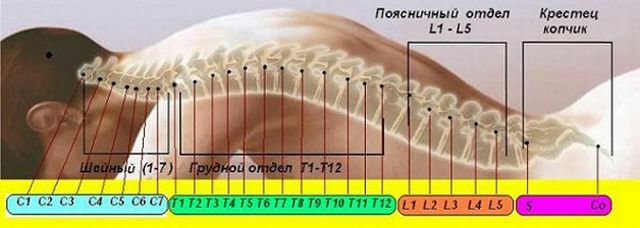
So, the features of a vertebral fracture depending on the placement of the vertebra in the lumbar region:
- Fracture of the 1st vertebra .This vertebra is the most vulnerable and often destroys its body. In the absence of complications and damage to the spinal cord, as well as in the case of timely therapy, a high prognosis for complete recovery is determined. Because of the high stresses on 1 vertebra, he often suffers from traumas caused by osteoporosis and as a result of strong mechanical influences. Fracture of the 2nd vertebra .The second vertebra is damaged less often than the first. And it happens for the same high loads. Due to a strong disruption of the structure of the 2nd vertebra, the whole segment is "blown out", which will also manifest itself in the area of the first and third vertebrae. If you do not prescribe treatment for this condition, the disorder can go to the upper and lower parts of the spine.
- Trauma in the 3rd vertebra of the .To damage the 3rd vertebra, there is less chance. Often it is damaged as a result of strikes on the zone of its localization. Inpatient treatment is prescribed, and depending on the severity level,
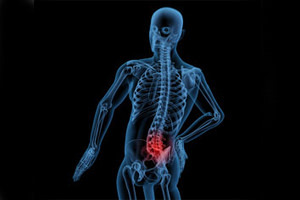 may require surgery. Due to improperly selected treatment in this area there is instability, spondylopathy and chronic pain.
may require surgery. Due to improperly selected treatment in this area there is instability, spondylopathy and chronic pain. - Damage in the area of the 4th vertebra .This vertebra is also rarely damaged. As a rule, on his body appear cracks due to compression, violations in 2 and 3 vertebrae. Fracture of 5th vertebra .The last vertebra connects with the base of the sacrum. Often, his fracture appears when falling on the buttocks and damage to the sacrum. Basically, pain appears in the lumbar region, but can spread to the groin area.
What you need to know about compression fracture of the spine, asked - we answer:
Diagnosis
Diagnostic tests for compression of the lumbar region are not complicated. Trauma can be determined by visual inspection based on patient complaints and the nature of the damage.
Visible deformation may also occur. To determine the spinal trauma you can move your legs, checking the sensitivity of the skin with a sterile needle.
In the inpatient setting, the lumbar radiograph is performed in 2 projections( lateral and direct).Also, a doctor can appoint an MRI and a CT scan.
Complex of medical measures
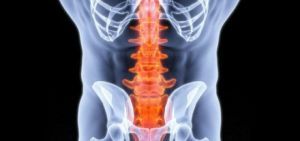 Treatment for suspected compression fracture of the lumbar spine should be prompt to avoid serious consequences of trauma.
Treatment for suspected compression fracture of the lumbar spine should be prompt to avoid serious consequences of trauma.
First pre-medical care is provided( several people put the victim on a stretcher, a bandage or a corset is applied to the fracture zone, pain therapy is done with pain).At the next stage, a medical examination, conservative or surgical treatment, and a recovery period are monitored.
Often no surgery is required, but sometimes it can not be avoided. Since the following methods are used for treatment:
- Medications .Medications are designed to relieve pain.
- Decreased physical activity of ( in walking and upright position, while standing).Elderly patients are recommended bed rest.
- Fixation of the lumbar corset , which will release the spine from unnecessary loads.
- Vertebroplasty .With this method, the damaged area of the back is strengthened and restored. In the process of
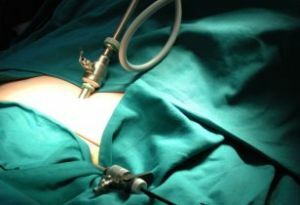 , a thin needle is inserted into the damaged area through which a special solution passes. Under X-ray control is carried out. To restore the patient need a day, after which his motor activity decreases.
, a thin needle is inserted into the damaged area through which a special solution passes. Under X-ray control is carried out. To restore the patient need a day, after which his motor activity decreases. - Cytoplasty .The procedure is based on the implementation of several incisions through which a balloon is injected into the vertebra, inflated to the desired value and a special cement is poured into the area of damage. The procedure allows to fix the position of the spine and normalize its parameters.
- Carrying out the operation .Intervention is performed when nerve endings are damaged. In the process of manipulation, the specialist removes damaged areas that pinch the brain with nerves, replacing them with metal implants.
- Sometimes can be performed in the lumbar region ( one time under local anesthesia on the orthopedic table, reposition - gradual change of the inclined angle on the orthopedic bed).
Rehabilitation period
The main goal of rehabilitation is the development of vertebral joints after removal of the corset or gypsum, strengthening the weak musculoskeletal system and preventing complications.
The most often used special complex exercise therapy, additionally prescribed physiotherapy, electrostimulation, manual therapy and massage.
In the rehabilitation course, three stages are distinguished: first the work of systems and organs is restored, the corset of muscles is strengthened and preparations for vertical position are carried out. The length of the rehabilitation period depends on the severity of the damage.
LFK can be performed in a hospital or at home under the supervision of a specialist. It is also recommended to visit the swimming pool.
Complexes of exercises of exercise therapy for compression fracture for each part of the spine from cervical to lumbar:
What is the danger of injury
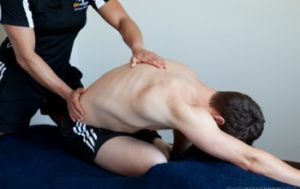 ? With compression fracture of the spine, complications can occur, frequent of which is instability of the spinal column in the lumbar region, neurological disorders and kyphotic deformationor a pointed hump in the thoracic region).
? With compression fracture of the spine, complications can occur, frequent of which is instability of the spinal column in the lumbar region, neurological disorders and kyphotic deformationor a pointed hump in the thoracic region).
With a compression of the 3rd degree, the risk of severe consequences increases.
To avoid complications, you should immediately contact a specialist for diagnosis and treatment.
How to avoid unnecessary problems
First of all, you should avoid unnecessary risks. It is necessary to observe the rules of the road, avoiding accidents, adhere to safety at work, train the muscles of the back and eat right.
If spinal injuries can not be avoided, you should consume foods containing vitamins and trace elements.
Necessary substances:
- in dairy products, cabbage, fish contains calcium ;
- in leafy vegetables, shrimps, bananas and nuts contains magnesium ;
- vitamin B6 and folic acid are a part of beans, bananas, beets, cabbage and liver;
- zinc is found in seafood, walnuts, oatmeal and buckwheat.

From the diet should exclude strong tea, coffee, lemonade, fatty foods, alcohol.
Also, preventive measures include caution in sports, active rest and treatment of osteoporosis.


